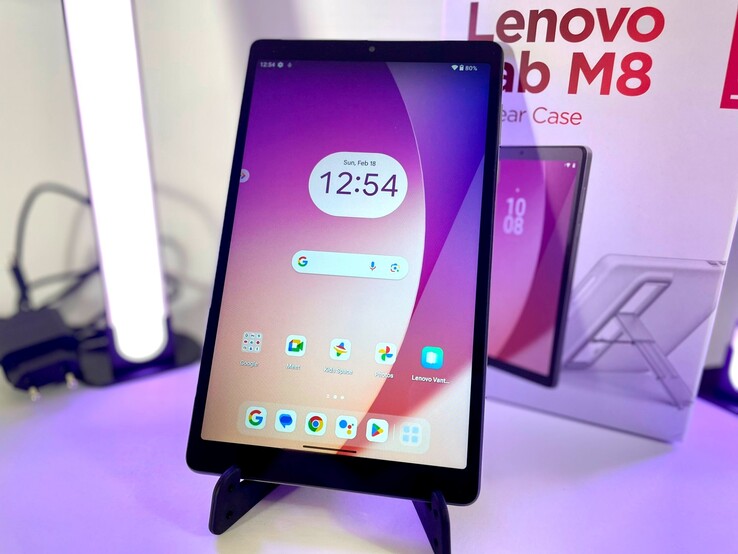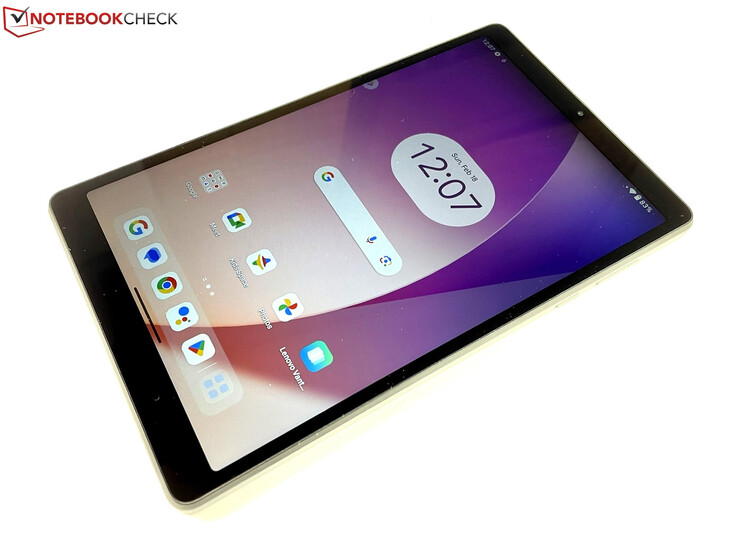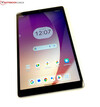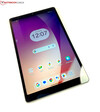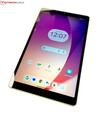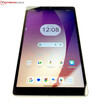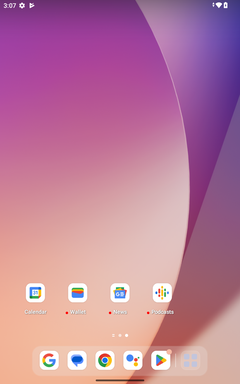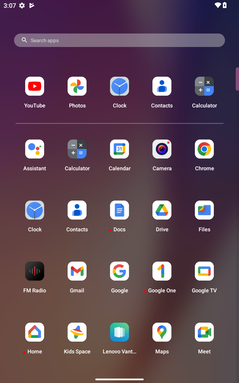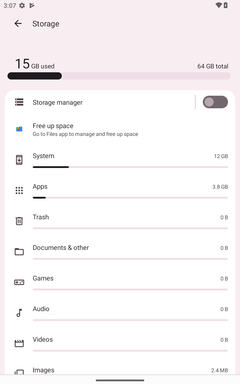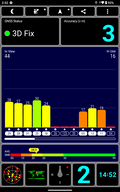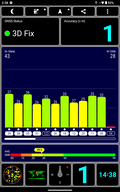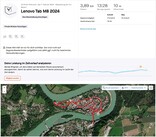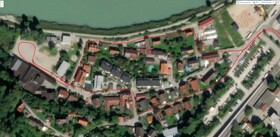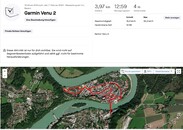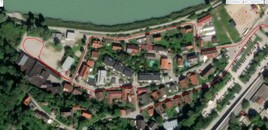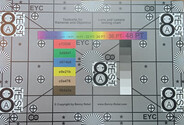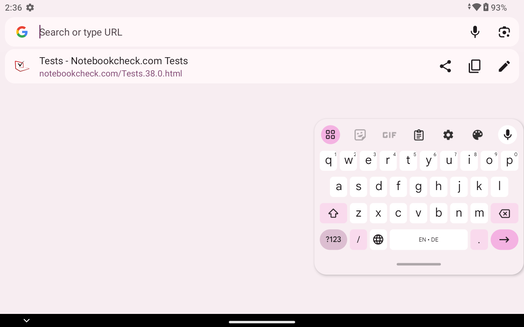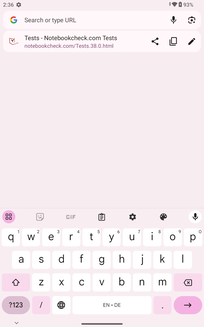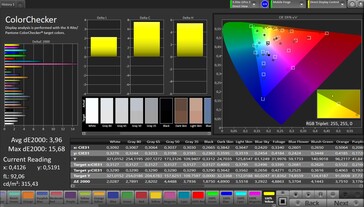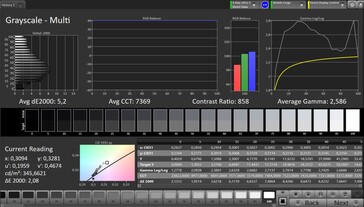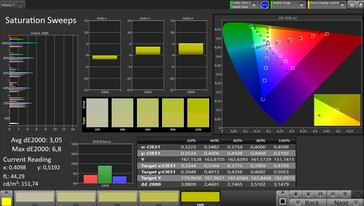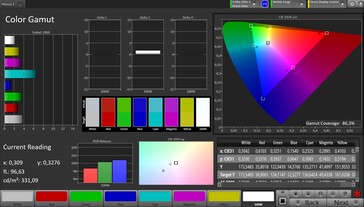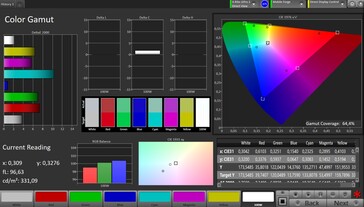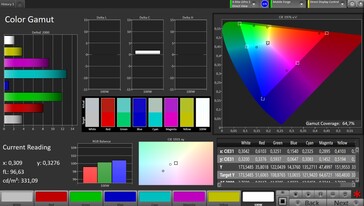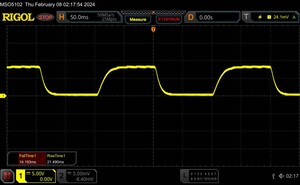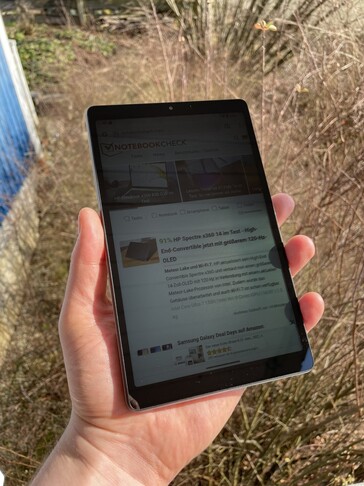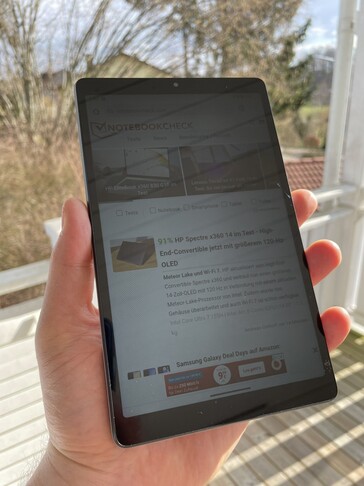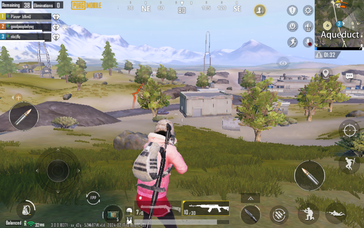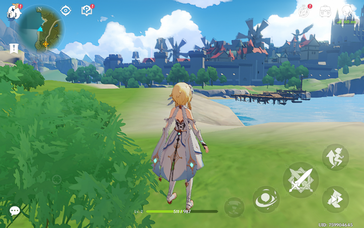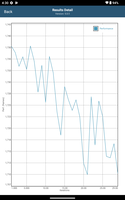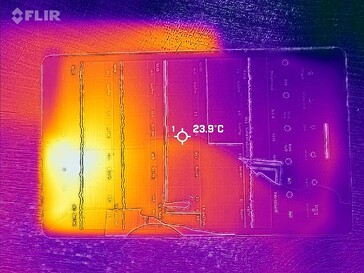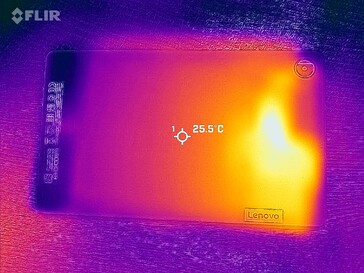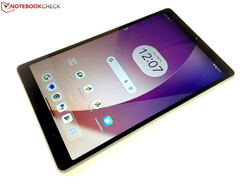Lenovo Tab M8 (Gen 4) 2024 review - A mini tablet with extra-long battery life
Small tablets with a screen diagonal of around 8 inches are light and portable, ideal for mobile use and are just as good a surfing the internet as they are for watching videos. They are also perfectly suited to children's hands. The small-sized tablets can usually be had at a budget price.
Curtain up for the Lenovo Tab M8 (Gen 4) 2024: The 8-inch tablet starts with an RRP of $119 and can be recommended for family use due to features which include Google Kids Space and it can even replace a smartphone in its TB301XU LTE version, as long as no better alternatives are at hand. We review the TB301FU Wi-Fi version and show what has improved since its predecessor, the Tab M8 (Gen 4) 2023.
Possible competitors compared
Rating | Date | Model | Weight | Height | Size | Resolution | Price |
|---|---|---|---|---|---|---|---|
| 80 % v7 (old) | 02 / 2024 | Lenovo Tab M8 2024 Helio MT8768, PowerVR GE8320 | 320 g | 8.95 mm | 8.00" | 1280x800 | |
| 80.4 % v7 (old) | 01 / 2023 | Amazon Fire HD 8 2022 MT8169A, Mali-G52 MP2 | 337 g | 9.7 mm | 8.00" | 1280x800 | |
| 79.5 % v7 (old) | 05 / 2023 | Lenovo Tab M8 (Gen 4) Helio A22 MT6761, PowerVR GE8300 | 320 g | 9 mm | 8.00" | 1280x800 | |
| 82.2 % v7 (old) | 02 / 2023 | Nokia T10 T7200 (T606), Mali-G57 MP1 | 375 g | 9 mm | 8.00" | 1280x800 | |
| 84.1 % v7 (old) | 02 / 2024 | Samsung Galaxy Tab A9 Helio G99, Mali-G57 MP2 | 332 g | 8 mm | 8.70" | 1340x800 |
Case - Light and handy
The Lenovo Tab M8 (Gen 4) 2024 finds itself in the exact same case as the Tab M8 (Gen 4) 2023. The new edition has also gone for plastic materials which tip the scale at 320 grams. This means it weighs less than the competing tablets such as the Nokia T10 or the Samsung Galaxy Tab A9.
The rear side of the Lenovo tablet is two-thirds covered in a stylish-looking, triangular pattern that gives the tablet a non-slip feel. The top third of the back cover's surface is smooth and, in addition to the Lenovo logo, it is home to the 5 MP main camera. Overall, the tablet has an impressively premium look and feel to it and can only be twisted minimally.
Lenovo offers the Tab M8 (Gen 4) 2024 in the colors Abyss blue and Arctic grey. However, in the EU, at the time of our review, only the gray color is available.
Features - Also available with optional LTE
The Tab M8 (Gen 4) 2024 comes in various specification options. In central Europe, Lenovo officially only offers its tablet in the TB301FU Wi-Fi version with 4 GB of RAM and 64 GB of eMMC storage, starting at 129 euros (around $119). For 158 euros (approximately $139), the Lenovo shop also has a 4/64 GB variant with a robust bumper that is especially aimed at children.
Anyone seeking the TB301XU LTE version will still find it quickly. With a 4G module, the tablet is available in local online stores just as cheaply as the Wi-Fi edition but only comes with 3 GB of RAM and 32 GB of mass storage. In its product database, Lenovo lists an additional 4/64 GB storage option but, at the time of testing, it is nowhere to be seen in stores. Now and again, W-Fi versions with 2/32 GB and 3/32GB are to be found in stores and they are even a little cheaper than our review version.
The USB-C port operates at USB 2.0 speeds and is OTG compatible. This means the tablet can be also connected to external storage media and put peripheral devices to use such as a mouse or a keyboard. Likewise, a 3.5 mm audio port is on board. As with its predecessor, NFC is not one of the features on offer.
microSD card reader
In our freshly set up Wi-Fi review version, 49 GB of the 64 GB storage are still free. If you need more storage space, the tablet can take a microSD card with a maximum capacity of up to 128 GB. Despite this, the card cannot be formatted to be used as internal storage meaning it can only store media data and not applications.
In tests with our Angelbird AV Pro V60 reference memory card, the Lenovo tablet delivered the kind of write and read performance you would expect for this category of device. But, the Samsung Galaxy Tab A9 shows that when it comes to copying data, even higher transfer speeds are achievable.
| SD Card Reader - average JPG Copy Test (av. of 3 runs) | |
| Samsung Galaxy Tab A9 (Angelbird AV Pro V60) | |
| Nokia T10 (Angelbird V60) | |
| Lenovo Tab M8 2024 (Angelbird V60) | |
| Lenovo Tab M8 (Gen 4) (Angelbird V60) | |
| Amazon Fire HD 8 2022 (Angelbird V60) | |
Cross Platform Disk Test (CPDT)
Software - Pure Android 13 and Widevine L1 for HD streaming
The Lenovo Tab M8 (Gen 4) 2024 runs an almost pure version of Android 13. The manufacturer has only added its in-house support tool, Lenovo Vantage. The Google Kids Space app is also along for the ride and, additionally, parents can set up a child-friendly and secure app and game environment for their kids. Unlike the predecessor, the Tab M8 (Gen 4) 2024 supports DRM Widevine L1 which also allows it to play streamed content in HD quality.
Lenovo wants to provide its tablet with security updates up to the first quarter of 2026. At the time of our review, in the middle of February, it was running the TB301FU_S000092_240116_ROW OS version. The included Android security updates from January 5th are therefore still relatively up-to-date.
Communications and GNSS - Stable WiFi 5 and accurate GPS
Every specification variant of the Tab M8 (Gen 4) 2024 comes with WiFi 5. Connected to our reference router, the Asus ROG Rapture GT-AXE11000, it achieved class-typical Wi-Fi transfer speeds which sat at a peak of 370 MBit/s and were stable in both sending and receiving directions. Likewise, the tablet supports Bluetooth 5.0.
| Networking | |
| iperf3 receive AXE11000 | |
| Samsung Galaxy Tab A9 | |
| Amazon Fire HD 8 2022 | |
| Lenovo Tab M8 2024 | |
| Nokia T10 | |
| Lenovo Tab M8 (Gen 4) | |
| iperf3 transmit AXE11000 | |
| Amazon Fire HD 8 2022 | |
| Samsung Galaxy Tab A9 | |
| Lenovo Tab M8 2024 | |
| Lenovo Tab M8 (Gen 4) | |
| Nokia T10 | |
To determine its position, the Tab M8 (Gen 4) 2024 uses the satellite navigation services GPS, Glonass, Galileo, Beidou and SBAS. Indoors, it was able to locate us quickly and accurately up to 3 meters and outdoors, even up to 1 meter.
As our practical test demonstrates, the Tab M8 (Gen 4) 2024 is very well suited to being used as a navigation device. On a small bike tour, it determined our position almost as precisely as our accompanying comparison device, the Garmin Venu 2 fitness smartwatch.
Cameras - A useable, fair-weather lens
The Tab M8 (Gen 4) 2024's main camera takes 5 MP shots and uses autofocus while the 2 MP selfie camera works with a fixed focus. Compared to the Tab M8 (Gen 4) 2023, this means nothing has changed.
The 5 MP lens is a "fair-weather camera" because it cannot handle poor lighting conditions at all. By contrast, in daylight, it does its job quite well and manages to take images with good contrast levels whose colors appear natural. However, picture sharpness isn't particularly great and, in dark areas, image details quickly deteriorate. The main camera shoots 30fps videos at a maximum resolution of 1080p which are of similar quality.
The 2 MP front camera takes relatively grainy selfies whose colors appear washed out. This camera shoots videos at a maximum of 720p at 30fps.
Image comparison
Choose a scene and navigate within the first image. One click changes the position on touchscreens. One click on the zoomed-in image opens the original in a new window. The first image shows the scaled photograph of the test device.
Daylight image 1Daylight image 2Lowlight imageUnder full studio lighting, the main camera shows that it can reproduce colors quite accurately (maximum Delta E of 11.7). However, the captured test chart images are blurry and washed out. At lowlight of 1 lux, the ColorChecker color card and the test chart disappear almost completely in the dark.
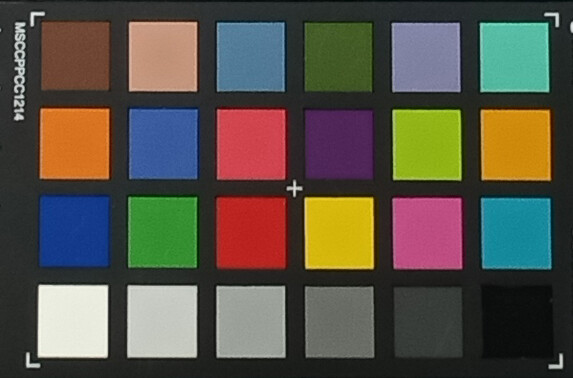

Accessories and warranty - Extendable up to 3 years
Included with the Tab M8 (Gen 4) 2024 are a 10-watt charger (5V/2A), a USB cable (Typ A to C), a SIM tool as well as a quick guide. The packaging also includes a practical transparent protective case with a kick-stand.
In the EU, Lenovo provides its tablets with a 24-month warranty. For a surcharge, the warranty can be extended to 3 years.
Input devices & operation - No biometric login possible
The Lenovo tablet's 60 Hz touchscreen recognizes inputs without any noticeable delays. However, things can get sluggish when multiple demanding applications or a game such as Genshin Impact are running. In our tests, attempts to either switch between apps or return to the home screen often required repeat inputs until the tablet finally responded. If you limit yourself to surfing the internet, watching videos or playing simple games, everything runs without a hitch.
The device cannot be biometrically unlocked since the tablet not only lacks a fingerprint sensor. The front camera also doesn't offer face recognition. User authentication is only possible via a pattern, PIN or password.
Display - A bright ADS panel without PWM
The same as its predecessor, the Lenovo tablet's display has a resolution of 1280 x 800 pixels. The only thing that has changed is the screen type. Instead of an IPS panel, the Tab M8 (Gen 4) 2024 relies on an ADS panel which, likewise, is only an IPS variant.
With a pure white background, the ADS panel shines with an average of 361 cd/m² (maximum 411 cd/m²) which fares well with the competition. With an even distribution of light and dark image areas (APL18 measurement), the brightness increases to up to 420 cd/m².
We didn't detect any display-related PWM flickering.
| |||||||||||||||||||||||||
Brightness Distribution: 81 %
Center on Battery: 411 cd/m²
Contrast: 1142:1 (Black: 0.36 cd/m²)
ΔE ColorChecker Calman: 3.96 | ∀{0.5-29.43 Ø4.78}
ΔE Greyscale Calman: 5.2 | ∀{0.09-98 Ø5}
86.3% sRGB (Calman 2D)
Gamma: 2.586
CCT: 7369 K
| Lenovo Tab M8 2024 ADS, 1280x800, 8" | Amazon Fire HD 8 2022 LCD, 1280x800, 8" | Lenovo Tab M8 (Gen 4) IPS, 1280x800, 8" | Nokia T10 IPS, 1280x800, 8" | Samsung Galaxy Tab A9 LCD TFT, 1340x800, 8.7" | |
|---|---|---|---|---|---|
| Screen | 8% | 25% | -9% | 7% | |
| Brightness middle (cd/m²) | 411 | 388 -6% | 410 0% | 446 9% | 486 18% |
| Brightness (cd/m²) | 361 | 364 1% | 380 5% | 429 19% | 462 28% |
| Brightness Distribution (%) | 81 | 90 11% | 86 6% | 94 16% | 92 14% |
| Black Level * (cd/m²) | 0.36 | 0.36 -0% | 0.16 56% | 0.65 -81% | 0.35 3% |
| Contrast (:1) | 1142 | 1078 -6% | 2563 124% | 686 -40% | 1389 22% |
| Colorchecker dE 2000 * | 3.96 | 4.38 -11% | 4.6 -16% | 4.87 -23% | 6.2 -57% |
| Colorchecker dE 2000 max. * | 15.68 | 10.7 32% | 9.03 42% | 9.85 37% | 10.4 34% |
| Greyscale dE 2000 * | 5.2 | 2.9 44% | 6.3 -21% | 5.7 -10% | 5.7 -10% |
| Gamma | 2.586 85% | 2.232 99% | 2.519 87% | 2.189 101% | 2.12 104% |
| CCT | 7369 88% | 6221 104% | 7707 84% | 7781 84% | 7911 82% |
* ... smaller is better
Screen Flickering / PWM (Pulse-Width Modulation)
| Screen flickering / PWM not detected | |||
In comparison: 53 % of all tested devices do not use PWM to dim the display. If PWM was detected, an average of 8111 (minimum: 5 - maximum: 343500) Hz was measured. | |||
If you leave all the display parameters at Standard settings, the ADS panel delivers solid image quality. Colors are displayed a little too cool. However, if required, the color temperature can be adjusted in the display settings via a color dial or via the three presets Standard, Warm and Cold. Additionally, you can switch from the Standard mode to Bright where the colors are displayed with better contrast.
Compared to the Tab M8 (Gen 4) 2023, the contrast ratio is worse. Previously sitting at 2500:1, our review device only managed 1142:1. For an ADS/IPS panel, that's still a score good enough to ensure vibrant color reproduction.
Display Response Times
| ↔ Response Time Black to White | ||
|---|---|---|
| 35.7 ms ... rise ↗ and fall ↘ combined | ↗ 14.2 ms rise | |
| ↘ 21.5 ms fall | ||
| The screen shows slow response rates in our tests and will be unsatisfactory for gamers. In comparison, all tested devices range from 0.1 (minimum) to 240 (maximum) ms. » 93 % of all devices are better. This means that the measured response time is worse than the average of all tested devices (20.2 ms). | ||
| ↔ Response Time 50% Grey to 80% Grey | ||
| 51.7 ms ... rise ↗ and fall ↘ combined | ↗ 29.8 ms rise | |
| ↘ 21.9 ms fall | ||
| The screen shows slow response rates in our tests and will be unsatisfactory for gamers. In comparison, all tested devices range from 0.165 (minimum) to 636 (maximum) ms. » 88 % of all devices are better. This means that the measured response time is worse than the average of all tested devices (31.6 ms). | ||
When it came to outdoor use, the tablet didn't impress us. Due to its low illumination reserves, the ADS panel already had difficulties when the sky was overcast and it was hard to display content legibly. But, indoors, the display's brightness is sufficient for stable viewing angles.
Performance - Not much power despite the new SoC
In its 2024 edition, the Lenovos 8-inch tablet performs better due to the switch from the Mediatek MT6761 to the Mediatek MT8768. However, we're not dealing with a performance leap since the MT8768 doesn't turn the tablet into a rocket.
Compared to similarly cheap tablets, the Tab M8 (Gen 4) 2024 can only secure a lower mid-table placing. It gets beaten by its predecessor in the synthetic benchmarks and lags behind the Nokia T10 and, in particular, the much faster Samsung Galaxy Tab A9. Overall, the tablet is about as fast as the Amazon Fire HD 2022.
| Antutu v9 - Total Score | |
| Average of class Tablet (126757 - 1247557, n=14, last 2 years) | |
| Samsung Galaxy Tab A9 | |
| Amazon Fire HD 8 2022 | |
| Lenovo Tab M8 2024 | |
| Average Mediatek MT8768 (n=1) | |
| Lenovo Tab M8 (Gen 4) | |
| Antutu v10 - Total Score | |
| Average of class Tablet (164396 - 3475590, n=70, last 2 years) | |
| Samsung Galaxy Tab A9 | |
| Lenovo Tab M8 2024 | |
| Average Mediatek MT8768 (n=1) | |
| CrossMark - Overall | |
| Average of class Tablet (227 - 2155, n=54, last 2 years) | |
| Samsung Galaxy Tab A9 | |
| Lenovo Tab M8 2024 | |
| Average Mediatek MT8768 (n=1) | |
| Lenovo Tab M8 (Gen 4) | |
| Amazon Fire HD 8 2022 | |
| AImark - Score v3.x | |
| Average of class Tablet (138 - 55794, n=52, last 2 years) | |
| Samsung Galaxy Tab A9 | |
| Lenovo Tab M8 2024 | |
| Average Mediatek MT8768 (n=1) | |
| Lenovo Tab M8 (Gen 4) | |
| UL Procyon AI Inference for Android - Overall Score NNAPI | |
| Average of class Tablet (2597 - 76852, n=62, last 2 years) | |
| Samsung Galaxy Tab A9 | |
| Amazon Fire HD 8 2022 | |
| Lenovo Tab M8 2024 | |
| Average Mediatek MT8768 (n=1) | |
Once more, when it comes to graphics benchmarks, the Tab M8 (Gen 4) 2024 has to not only admit defeat to the Nokia T10 and the Samsung Galaxy Tab A9 but also the Amazon Fire HD 2022. As the T-Rex GFXBench benchmark shows, even at low graphics settings, games don't run smoothly but are still capable of achieving frame rates of 30fps.
GFXBench (DX / GLBenchmark) 2.7: T-Rex Onscreen | 1920x1080 T-Rex Offscreen
GFXBench 3.0: on screen Manhattan Onscreen OGL | 1920x1080 1080p Manhattan Offscreen
GFXBench 3.1: on screen Manhattan ES 3.1 Onscreen | 1920x1080 Manhattan ES 3.1 Offscreen
GFXBench: on screen Car Chase Onscreen | 1920x1080 Car Chase Offscreen | on screen Aztec Ruins High Tier Onscreen | 2560x1440 Aztec Ruins High Tier Offscreen | on screen Aztec Ruins Normal Tier Onscreen | 1920x1080 Aztec Ruins Normal Tier Offscreen | 3840x2160 4K Aztec Ruins High Tier Offscreen
| 3DMark / Sling Shot Extreme (ES 3.1) Unlimited | |
| Samsung Galaxy Tab A9 | |
| Nokia T10 | |
| Amazon Fire HD 8 2022 | |
| Lenovo Tab M8 2024 | |
| 3DMark / Sling Shot Extreme (ES 3.1) Unlimited Graphics | |
| Samsung Galaxy Tab A9 | |
| Nokia T10 | |
| Amazon Fire HD 8 2022 | |
| Lenovo Tab M8 2024 | |
| 3DMark / Sling Shot Extreme (ES 3.1) Unlimited Physics | |
| Samsung Galaxy Tab A9 | |
| Nokia T10 | |
| Amazon Fire HD 8 2022 | |
| Lenovo Tab M8 2024 | |
| GFXBench (DX / GLBenchmark) 2.7 / T-Rex Onscreen | |
| Samsung Galaxy Tab A9 | |
| Amazon Fire HD 8 2022 | |
| Lenovo Tab M8 2024 | |
| Lenovo Tab M8 (Gen 4) | |
| GFXBench (DX / GLBenchmark) 2.7 / T-Rex Offscreen | |
| Samsung Galaxy Tab A9 | |
| Amazon Fire HD 8 2022 | |
| Lenovo Tab M8 2024 | |
| Lenovo Tab M8 (Gen 4) | |
| GFXBench 3.0 / Manhattan Onscreen OGL | |
| Samsung Galaxy Tab A9 | |
| Amazon Fire HD 8 2022 | |
| Lenovo Tab M8 2024 | |
| Lenovo Tab M8 (Gen 4) | |
| GFXBench 3.0 / 1080p Manhattan Offscreen | |
| Samsung Galaxy Tab A9 | |
| Amazon Fire HD 8 2022 | |
| Lenovo Tab M8 2024 | |
| Lenovo Tab M8 (Gen 4) | |
| GFXBench 3.1 / Manhattan ES 3.1 Onscreen | |
| Samsung Galaxy Tab A9 | |
| Amazon Fire HD 8 2022 | |
| Lenovo Tab M8 2024 | |
| Lenovo Tab M8 (Gen 4) | |
| GFXBench 3.1 / Manhattan ES 3.1 Offscreen | |
| Samsung Galaxy Tab A9 | |
| Amazon Fire HD 8 2022 | |
| Lenovo Tab M8 2024 | |
| Lenovo Tab M8 (Gen 4) | |
| GFXBench / Car Chase Onscreen | |
| Samsung Galaxy Tab A9 | |
| Amazon Fire HD 8 2022 | |
| Lenovo Tab M8 2024 | |
| Lenovo Tab M8 (Gen 4) | |
| GFXBench / Car Chase Offscreen | |
| Samsung Galaxy Tab A9 | |
| Amazon Fire HD 8 2022 | |
| Lenovo Tab M8 2024 | |
| Lenovo Tab M8 (Gen 4) | |
| GFXBench / Aztec Ruins High Tier Onscreen | |
| Samsung Galaxy Tab A9 | |
| Nokia T10 | |
| Amazon Fire HD 8 2022 | |
| Lenovo Tab M8 2024 | |
| Lenovo Tab M8 (Gen 4) | |
| GFXBench / Aztec Ruins High Tier Offscreen | |
| Samsung Galaxy Tab A9 | |
| Amazon Fire HD 8 2022 | |
| Nokia T10 | |
| Lenovo Tab M8 2024 | |
| Lenovo Tab M8 (Gen 4) | |
| GFXBench / Aztec Ruins Normal Tier Onscreen | |
| Samsung Galaxy Tab A9 | |
| Amazon Fire HD 8 2022 | |
| Nokia T10 | |
| Lenovo Tab M8 2024 | |
| Lenovo Tab M8 (Gen 4) | |
| GFXBench / Aztec Ruins Normal Tier Offscreen | |
| Samsung Galaxy Tab A9 | |
| Amazon Fire HD 8 2022 | |
| Nokia T10 | |
| Lenovo Tab M8 2024 | |
| Lenovo Tab M8 (Gen 4) | |
| GFXBench / 4K Aztec Ruins High Tier Offscreen | |
| Samsung Galaxy Tab A9 | |
| Nokia T10 | |
| Lenovo Tab M8 2024 | |
| Lenovo Tab M8 (Gen 4) | |
The Lenovo tablet can quickly scroll through websites but it sometimes takes quite a while before they have finished loading. The browser benchmark scores are therefore only sufficient to secure a mid-table ranking.
| Jetstream 2 - 2.0 Total Score | |
| Average of class Tablet (22.3 - 395, n=67, last 2 years) | |
| Samsung Galaxy Tab A9 (Chrome 212) | |
| Amazon Fire HD 8 2022 (Silk Browser 106) | |
| Lenovo Tab M8 2024 (Chrome 121.0.6167.178) | |
| Lenovo Tab M8 (Gen 4) (Chrome 112) | |
| Average Mediatek MT8768 (14 - 23.3, n=3) | |
| WebXPRT 4 - Overall | |
| Average of class Tablet (26 - 376, n=71, last 2 years) | |
| Samsung Galaxy Tab A9 (Chrome 212) | |
| Lenovo Tab M8 2024 (Chrome 121.0.6167.178) | |
| Average Mediatek MT8768 (n=1) | |
| Amazon Fire HD 8 2022 (Silk Browser 106) | |
| Lenovo Tab M8 (Gen 4) (Chrome 112) | |
| WebXPRT 3 - Overall | |
| Average of class Tablet (39 - 480, n=25, last 2 years) | |
| Samsung Galaxy Tab A9 (Chrome 212) | |
| Lenovo Tab M8 (Gen 4) (Chrome 112) | |
| Lenovo Tab M8 2024 (Chrome 121.0.6167.178) | |
| Amazon Fire HD 8 2022 (Silk Browser 106) | |
| Average Mediatek MT8768 (24 - 39, n=4) | |
| Speedometer 2.0 - Result 2.0 | |
| Average of class Tablet (2.59 - 790, n=55, last 2 years) | |
| Samsung Galaxy Tab A9 (Chrome 212) | |
| Lenovo Tab M8 2024 (Chrome 121.0.6167.178) | |
| Amazon Fire HD 8 2022 (Silk Browser 106) | |
| Average Mediatek MT8768 (13.3 - 17.3, n=2) | |
| Lenovo Tab M8 (Gen 4) (Chome 112) | |
| Octane V2 - Total Score | |
| Average of class Tablet (763 - 138481, n=95, last 2 years) | |
| Samsung Galaxy Tab A9 (Chrome 212) | |
| Nokia T10 (Chrome 109) | |
| Lenovo Tab M8 2024 (Chrome 121.0.6167.178) | |
| Amazon Fire HD 8 2022 (Silk Browser 106) | |
| Lenovo Tab M8 (Gen 4) (Chrome 112) | |
| Average Mediatek MT8768 (4070 - 6281, n=3) | |
| Mozilla Kraken 1.1 - Total | |
| Average Mediatek MT8768 (10163 - 12342, n=4) | |
| Lenovo Tab M8 2024 (Chrome 121.0.6167.178) | |
| Amazon Fire HD 8 2022 (Silk Browser 106) | |
| Lenovo Tab M8 (Gen 4) (Chrome 112) | |
| Average of class Tablet (243 - 27101, n=80, last 2 years) | |
| Samsung Galaxy Tab A9 (Chrome 212) | |
* ... smaller is better
As a result of the slow eMMC storage, the Tab M8 (Gen 4) 2024 achieves neither quick loading times nor fast data transfer. Apart from the Samsung Galaxy Tab A9 and, in part, the Nokia T10, the competition also doesn't do any better.
| Lenovo Tab M8 2024 | Amazon Fire HD 8 2022 | Lenovo Tab M8 (Gen 4) | Nokia T10 | Samsung Galaxy Tab A9 | Average 64 GB eMMC Flash | Average of class Tablet | |
|---|---|---|---|---|---|---|---|
| AndroBench 3-5 | -24% | 1% | 60% | 252% | 10% | 649% | |
| Sequential Read 256KB (MB/s) | 282.52 | 270.37 -4% | 269.6 -5% | 273.5 -3% | 916.45 224% | 277 ? -2% | 1805 ? 539% |
| Sequential Write 256KB (MB/s) | 204.02 | 113.44 -44% | 190.5 -7% | 191.5 -6% | 398.32 95% | 178.4 ? -13% | 1347 ? 560% |
| Random Read 4KB (MB/s) | 64.31 | 39.46 -39% | 67 4% | 71.4 11% | 182.74 184% | 60.7 ? -6% | 246 ? 283% |
| Random Write 4KB (MB/s) | 21.3 | 19.81 -7% | 23.9 12% | 71.5 236% | 128.92 505% | 33.8 ? 59% | 280 ? 1215% |
Games - Not a lot of fun on this tablet
With a small selection of games, we analyzed how all current games run on the Tab M8 (Gen 4) 2024. The result was more bad than good.
At best, PUBG Mobile can only be launched in the second lowest Balanced graphics mode and even then it struggles to reach the game's frame rate limit of 30fps. In the Smooth graphics mode, there are also significant and regular frame rate dips. On the tablet's lowest detail setting, Genshin Impact doesn't improve on being a slideshow and remains just about playable with an average frame rate of 15fps.
We recorded the game's framerates using our Gamebench test tool.
Emissions - The Tab M8 (Gen 4) 2024 has stereo speakers
Temperature
Even under load, the Tab M8 (Gen 4) 2024 remains cool and only heats up to a maximum of 38.2 °C after a one-hour stress test with the demanding Burnout benchmark. The SoC is incompatible with 3DMark's Wild Life stress test which is why we turned to GFXBench. Using this, the tablet showed that it is capable of consistent performance also under longer periods of load.
(+) The maximum temperature on the upper side is 35.3 °C / 96 F, compared to the average of 33.7 °C / 93 F, ranging from 20.7 to 53.2 °C for the class Tablet.
(+) The bottom heats up to a maximum of 38.2 °C / 101 F, compared to the average of 33.2 °C / 92 F
(+) In idle usage, the average temperature for the upper side is 21.6 °C / 71 F, compared to the device average of 30 °C / 86 F.
Speakers
The small Lenovo tablet houses stereo speakers which can be found on both short sides of the device. They sound a little tinny with almost a complete absence of bass but they still create a good sound stage for a device in this price category.
External audio devices can connect to the tablet either via the 3.5 mm audio jack or Bluetooth 5.0. The supported Bluetooth codecs are AAC, aptX, aptX HD, LDAC and SBC.
Lenovo Tab M8 2024 audio analysis
(±) | speaker loudness is average but good (77.5 dB)
Bass 100 - 315 Hz
(-) | nearly no bass - on average 27.2% lower than median
(±) | linearity of bass is average (10.8% delta to prev. frequency)
Mids 400 - 2000 Hz
(+) | balanced mids - only 4.3% away from median
(+) | mids are linear (5.5% delta to prev. frequency)
Highs 2 - 16 kHz
(±) | higher highs - on average 5.7% higher than median
(±) | linearity of highs is average (7.4% delta to prev. frequency)
Overall 100 - 16.000 Hz
(±) | linearity of overall sound is average (24.6% difference to median)
Compared to same class
» 75% of all tested devices in this class were better, 7% similar, 18% worse
» The best had a delta of 7%, average was 20%, worst was 129%
Compared to all devices tested
» 74% of all tested devices were better, 6% similar, 20% worse
» The best had a delta of 4%, average was 24%, worst was 134%
Samsung Galaxy Tab A9 audio analysis
(+) | speakers can play relatively loud (86.6 dB)
Bass 100 - 315 Hz
(-) | nearly no bass - on average 26.5% lower than median
(±) | linearity of bass is average (10.1% delta to prev. frequency)
Mids 400 - 2000 Hz
(±) | higher mids - on average 6.9% higher than median
(+) | mids are linear (6.8% delta to prev. frequency)
Highs 2 - 16 kHz
(±) | higher highs - on average 7.2% higher than median
(+) | highs are linear (3.5% delta to prev. frequency)
Overall 100 - 16.000 Hz
(±) | linearity of overall sound is average (24.4% difference to median)
Compared to same class
» 75% of all tested devices in this class were better, 7% similar, 18% worse
» The best had a delta of 7%, average was 20%, worst was 129%
Compared to all devices tested
» 73% of all tested devices were better, 6% similar, 21% worse
» The best had a delta of 4%, average was 24%, worst was 134%
Energy management - A 5,100 mAh battery with endurance runner qualities
Power consumption
The Lenovo Tab M8 (Gen 4) 2024 can be charged at up to 10 watts via the included USB charger. In tests, a complete charging cycle took approximately 3 hours.
In terms of power consumption, the tablet beats all the other competing devices in the comparison field. At an average of only 1 watt running idle and 2.5 watts under load, it runs very energy efficiently and manages to beat the very economical Amazon Fire HD 8 2022.
| Off / Standby | |
| Idle | |
| Load |
|
Key:
min: | |
| Lenovo Tab M8 2024 5100 mAh | Amazon Fire HD 8 2022 4850 mAh | Lenovo Tab M8 (Gen 4) 5100 mAh | Samsung Galaxy Tab A9 5100 mAh | |
|---|---|---|---|---|
| Power Consumption | -27% | -65% | -120% | |
| Idle Minimum * (Watt) | 0.7 | 1.2 -71% | 1.7 -143% | 0.7 -0% |
| Idle Average * (Watt) | 1 | 1.4 -40% | 1.9 -90% | 2.94 -194% |
| Idle Maximum * (Watt) | 1.3 | 1.7 -31% | 2.4 -85% | 3.03 -133% |
| Load Average * (Watt) | 2.5 | 2.5 -0% | 3 -20% | 7.49 -200% |
| Load Maximum * (Watt) | 4.6 | 4.3 7% | 3.9 15% | 8.02 -74% |
* ... smaller is better
Power consumption: Geekbench (150 cd/m²)
Power consumption: GFXBench (150 cd/m²)
Battery life
At 19 hours of simulated internet use and 19 hours 23 minutes playing an HD video in a continuous loop, the Tab M8 (Gen 4) 2024 has wonderful battery life. Even under full load, the tablet refuses to back down and can keep going for more than 6 hours. The battery runtimes are better than average also when compared to other cheap tablets.
All in all, in tests, the Lenovo shows itself to be a marathon runner that has the stamina to last a few consecutive days of average load before it needs recharging.
| Lenovo Tab M8 2024 5100 mAh | Amazon Fire HD 8 2022 4850 mAh | Lenovo Tab M8 (Gen 4) 5100 mAh | Nokia T10 5250 mAh | Samsung Galaxy Tab A9 5100 mAh | |
|---|---|---|---|---|---|
| Battery runtime | -18% | -23% | -14% | -21% | |
| Reader / Idle (h) | 48.1 | 37.1 -23% | 32.2 -33% | ||
| H.264 (h) | 19.4 | 16.6 -14% | 19.3 -1% | ||
| WiFi v1.3 (h) | 19 | 15.6 -18% | 15.5 -18% | 16.4 -14% | 14.3 -25% |
| Load (h) | 6.1 | 3.8 -38% | 4.6 -25% |
Pros
Cons
Verdict - Lenovo Tab M8 (Gen 4) 2024
The Lenovo Tab M8 (Gen 4) 2024 is an affordable surfing and multimedia tablet that even fits well in children's hands due to its form factor and weight of only 320 grams.
Stereo speakers, precise GPS, a streamlined, bloatware-lacking Android 13, a bright display and optional LTE are all advantages the small tablet can claim for itself. But, the highlight, without a doubt, is the battery life. While the Tab M8 (Gen 4) 2023 only delivered average fare, the Tab M8 (Gen 4) 2024's runtimes have improved noticeably - despite having the same-sized 5,100 mAh battery - and are much better than many similarly cheap tablets.
The Lenovo Tab M8 (Gen 4) 2024 is a reasonably-priced tablet that has a good feature set which includes optional LTE but doesn't offer much in the way of power.
With the help of DRM Widevine L1 support, the Lenovo can also play web streams in HD quality, unlike its predecessor. So, the tablet does entertainment but not a lot else since its Mediatek SoC MT8768 is too slow for demanding tasks. Games only run with major limitations and things get sluggish when multiple apps are open simultaneously.
Alternatives to the Lenovo Tab M8 (Gen 4) 2024 can be found, for example, in the form of the Nokia T10 and the Samsung Galaxy Tab A9. Both devices are similarly cheap but offer significantly more power.
Price and availability
The Lenovo Tab M8 (Gen 4) 2024 costs $84.99 in the 2 GB/32 GB Wi-Fi version if ordered from the Lenovo online store. In addition, the same spec tablet can currently be purchased for $84.99 on Amazon.
Lenovo Tab M8 2024
- 02/22/2024 v7 (old)
Manuel Masiero
Transparency
The selection of devices to be reviewed is made by our editorial team. The test sample was freely purchased by the author at his/her own expense. The lender had no influence on this review, nor did the manufacturer receive a copy of this review before publication. There was no obligation to publish this review. As an independent media company, Notebookcheck is not subjected to the authority of manufacturers, retailers or publishers.
This is how Notebookcheck is testing
Every year, Notebookcheck independently reviews hundreds of laptops and smartphones using standardized procedures to ensure that all results are comparable. We have continuously developed our test methods for around 20 years and set industry standards in the process. In our test labs, high-quality measuring equipment is utilized by experienced technicians and editors. These tests involve a multi-stage validation process. Our complex rating system is based on hundreds of well-founded measurements and benchmarks, which maintains objectivity. Further information on our test methods can be found here.




